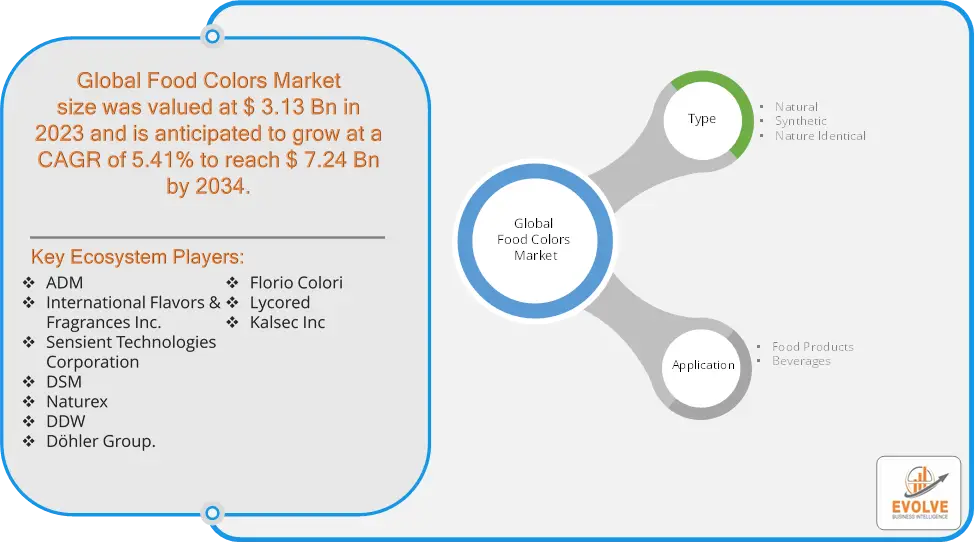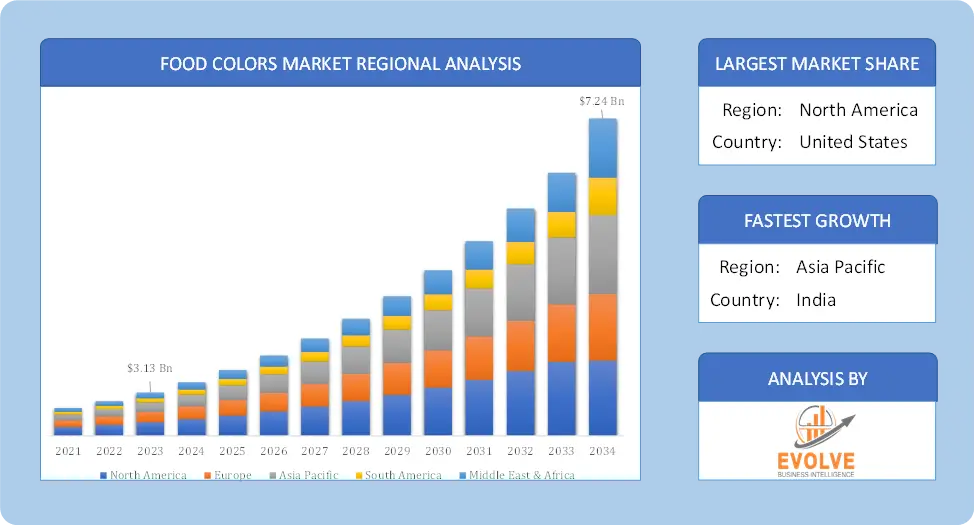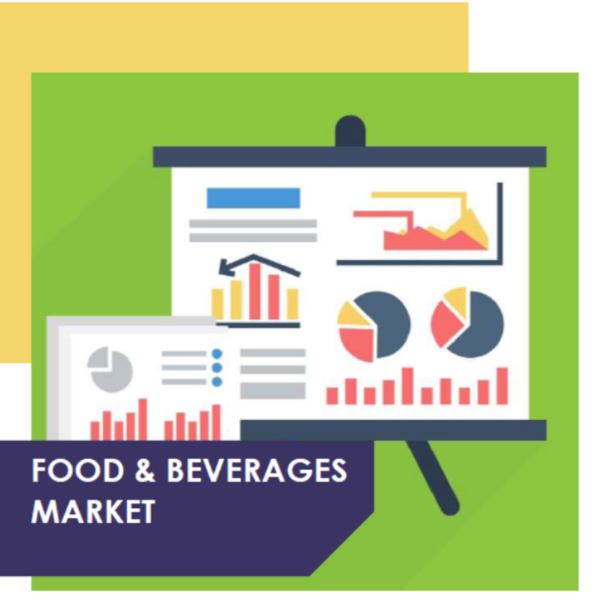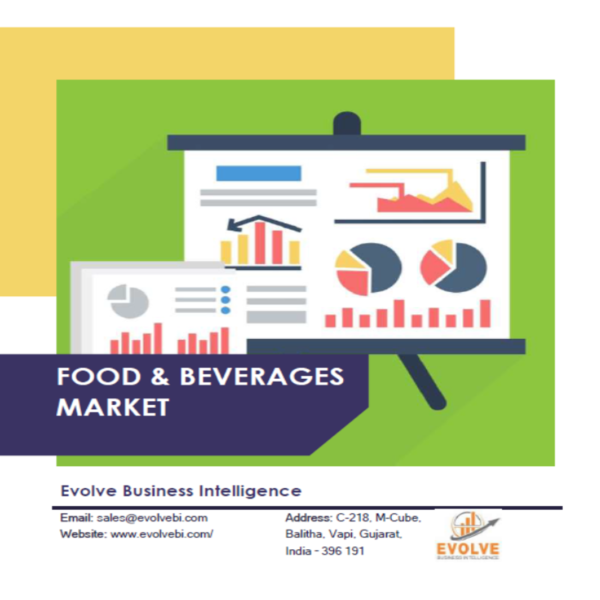Food Colors Market Overview
The Food Colors Market Size is expected to reach USD 7.24 Billion by 2033. The Food Colors Market industry size accounted for USD 3.13 Billion in 2023 and is expected to expand at a compound annual growth rate (CAGR) of 5.41% from 2023 to 2033. The Food Colors Market involves the production, distribution, and use of color additives in food products. These colors are used to enhance or change the appearance of food, making it more visually appealing or aligning it with consumer expectations.
The Food Colors Market is influenced by trends in consumer preferences, technological advancements, and regulatory changes. The food colors market is a dynamic industry that plays a crucial role in the appearance and appeal of many food products.
Global Food Colors Market Synopsis
 Food Colors Market Dynamics
Food Colors Market Dynamics
The major factors that have impacted the growth of Food Colors Market are as follows:
Drivers:
Ø Innovation and Technology
Advances in food color technology, including the development of new natural colorants and improved stabilization techniques, contribute to market growth. Innovations allow for better color stability, solubility, and compatibility with various food products. Increasing global trade and cross-border food consumption expand market opportunities for food colors. Different regions have distinct preferences and color trends, creating a diverse market landscape. The rise in demand for processed and packaged foods, which often require color additives to maintain visual appeal and consistency, supports the growth of the food colors market.
Restraint:
- Perception of Health Concerns and Cost of Natural Colors
Increasing awareness and concerns about the potential health risks associated with synthetic food colors, such as allergies, hyperactivity in children, and long-term health effects, can lead to reduced demand for these products. Consumers are increasingly seeking natural alternatives. Natural food colors are often more expensive than synthetic counterparts due to higher production costs and limited availability. This can be a barrier for manufacturers, particularly in price-sensitive markets.
Opportunity:
⮚ Rising Demand for Natural and Organic Products
There is increasing consumer preference for natural and organic food products. Manufacturers can capitalize on this trend by developing and offering natural food colors derived from fruits, vegetables, and other natural sources. Advances in food color technology, including the development of new natural colorants, improved stabilization methods, and innovative delivery systems, create opportunities for product differentiation and enhanced performance. The growth of the global food and beverage industry, including the rise of processed and convenience foods, offers opportunities for food color suppliers to meet the needs of a diverse range of products.
Food Colors Market Segment Overview
By Type
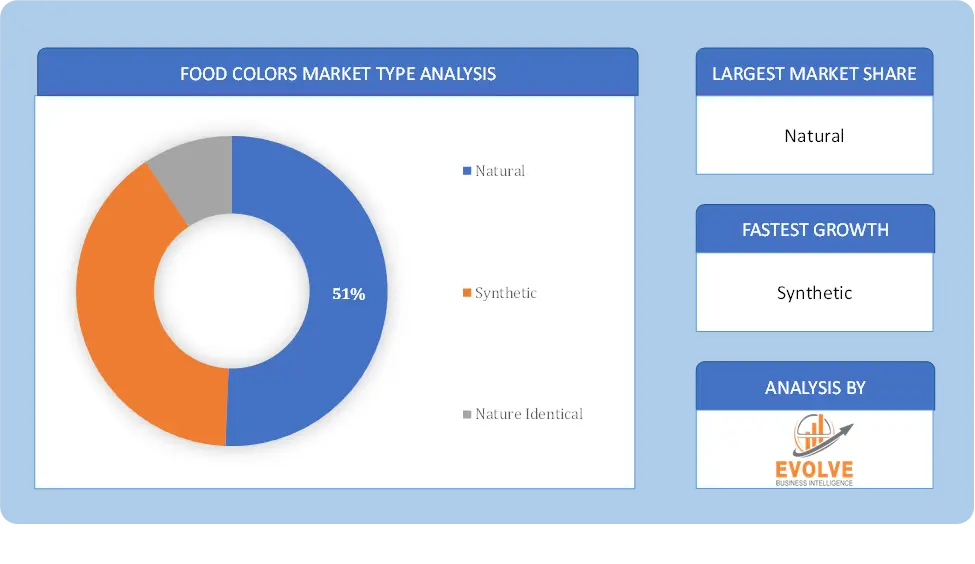 Based on Type, the market is segmented based on Natural, Synthetic and Nature-identical. The natural segment dominant the market. Natural food colors have beneficial and organic properties of natural sources, driving demand for natural colors. Growing consumer awareness of the health benefits of natural food colors has increased demand for this product source on a global scale. Natural colorings are made entirely from naturally occurring materials like fruits, vegetables, and tubers. It has been demonstrated that adding natural colorings to meals increases their nutritional value and aesthetic appeal.
Based on Type, the market is segmented based on Natural, Synthetic and Nature-identical. The natural segment dominant the market. Natural food colors have beneficial and organic properties of natural sources, driving demand for natural colors. Growing consumer awareness of the health benefits of natural food colors has increased demand for this product source on a global scale. Natural colorings are made entirely from naturally occurring materials like fruits, vegetables, and tubers. It has been demonstrated that adding natural colorings to meals increases their nutritional value and aesthetic appeal.
By Application
Based on Application, the market has been divided into Food Products and Beverages. The beverages segment dominated the market. Food colors are essential components of processed foods and beverages. Soft drinks are widely consumed worldwide, owing to aggressive advertising by manufacturers. Sodas are advertised in supermarkets, restaurants, gas stations, museums, and schools for billions of dollars. As a result, food coloring is being used more frequently in soft drinks, which is anticipated to increase segment revenue. Food colors enhance the visual appeal of uncolored or off-colored products, like beverages.
Global Food Colors Market Regional Analysis
Based on region, the global Food Colors Market has been divided into North America, Europe, Asia-Pacific, the Middle East & Africa, and Latin America. North America is projected to dominate the use of the Food Colors Market followed by the Asia-Pacific and Europe regions.
 Food Colors North America Market
Food Colors North America Market
North America holds a dominant position in the Food Colors Market. Countries like United States and Canada has high demand for both synthetic and natural food colors, driven by a well-established food and beverage industry. Consumers are increasingly leaning towards natural colors due to health concerns. Increasing focus on natural and organic food colors and strict regulations and safety standards govern the use of food colors, influencing market trends and product offerings.
Food Colors Asia-Pacific Market
The Asia-Pacific region has indeed emerged as the fastest-growing market for the Food Colors Market industry. Rising demand for processed foods and beverages, especially in China and India. Growing preference for natural food colors and China and India has rapid urbanization, a growing middle class, and increasing disposable incomes drive the demand for food colors. There is a notable shift towards natural colors as consumers become more health-conscious.
Competitive Landscape
The global Food Colors Market is highly competitive, with numerous players offering a wide range of software solutions. The competitive landscape is characterized by the presence of established companies, as well as emerging startups and niche players. To increase their market position and attract a wide consumer base, the businesses are employing various strategies, such as product launches, and strategic alliances.
Prominent Players:
- ADM
- International Flavors & Fragrances Inc.
- Sensient Technologies Corporation
- DSM
- Naturex
- DDW
- Döhler Group.
- Florio Colori
- Lycored
- Kalsec Inc
Key Development
In July 2021, Givaudan announced the acquisition of Alderys, a French company specializing in natural ingredients used in the food, cosmetics, and fragrance industries. This strategic move expanded Givaudan’s portfolio of natural and clean-label ingredients for food colorants.
In January 2021, Kalsec Inc. launched a new line of heat-stable natural colors derived from paprika and annatto, addressing the industry’s need for stable natural colors in various food applications, including snacks and seasonings.
Scope of the Report
Global Food Colors Market, by Type
- Natural
- Synthetic
- Nature Identical
Global Food Colors Market, by Application
- Food Products
- Beverages
Global Food Colors Market, by Region
- North America
- US
- Canada
- Mexico
- Europe
- UK
- Germany
- France
- Italy
- Spain
- Benelux
- Nordic
- Rest of Europe
- Asia Pacific
- China
- Japan
- South Korea
- Indonesia
- Austalia
- Malaysia
- India
- Rest of Asia Pacific
- South America
- Brazil
- Argentina
- Rest of South America
- Middle East & Africa
- Saudi Arabia
- UAE
- Egypt
- South Africa
- Rest of Middle East & Africa
| Parameters | Indicators |
|---|---|
| Market Size | 2033: $7.24 Billion |
| CAGR | 5.41% CAGR (2023-2033) |
| Base year | 2022 |
| Forecast Period | 2023-2033 |
| Historical Data | 2021 |
| Report Coverage | Revenue Forecast, Competitive Landscape, Growth Factors, and Trends |
| Key Segmentations | Type, Application |
| Geographies Covered | North America, Europe, Asia-Pacific, Latin America, Middle East, Africa |
| Key Vendors | ADM, International Flavors & Fragrances Inc., Sensient Technologies Corporation, DSM, Naturex, DDW, Döhler Group., Florio Colori, Lycored and Kalsec Inc |
| Key Market Opportunities | • Rising Demand for Natural and Organic Products • Innovation in Food Color Technology |
| Key Market Drivers | • Innovation and Technology • Globalization and Growth in Processed Foods |
REPORT CONTENT BRIEF:
- High-level analysis of the current and future Food Colors Market trends and opportunities
- Detailed analysis of current market drivers, restraining factors, and opportunities in the future
- Food Colors Market historical market size for the year 2021, and forecast from 2023 to 2033
- Food Colors Market share analysis at each product level
- Competitor analysis with detailed insight into its product segment, Government & Defense strength, and strategies adopted.
- Identifies key strategies adopted including product launches and developments, mergers and acquisitions, joint ventures, collaborations, and partnerships as well as funding taken and investment done, among others.
- To identify and understand the various factors involved in the global Food Colors Market affected by the pandemic
- To provide a detailed insight into the major companies operating in the market. The profiling will include the Government & Defense health of the company’s past 2-3 years with segmental and regional revenue breakup, product offering, recent developments, SWOT analysis, and key strategies.


